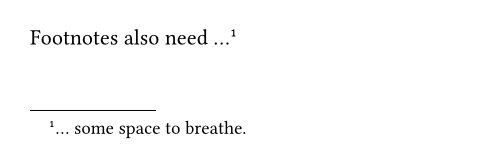このページは日本語に翻訳済みです。
footnote要素関数要素関数要素関数はsetルールやshowルールでカスタマイズできます。
setルールやshowルールでカスタマイズできます。脚注。
脚注を用いて追加のコメントや参考文献を同じページに記述します。 脚注は、ページ下部の注釈にリンクする上付きの番号を挿入します。 注釈は文書全体で連続して番号付けされ、 複数のページにまたがることができます。
脚注リストの項目の外観をカスタマイズするには、
footnote.entryを参照してください。
脚注自体は通常の上付き文字として実現されているため、
super関数に対してsetルールを適用してカスタマイズできます。
また、showルールを適用して、本文中の脚注マーカー(上付き番号)のみをカスタマイズすることもできます。
例
Check the docs for more details.
#footnote[https://typst.app/docs]

脚注は、マークアップにおいて前の単語との間にスペースがあったとしても、
自動的にその単語に付加されます。
スペースを強制するには、文字列の#" "や明示的なhorizontal spacingを使用できます。
脚注にラベルをつけることにより、脚注に対して複数の参照を持つことができます。
You can edit Typst documents online.
#footnote[https://typst.app/app] <fn>
Checkout Typst's website. @fn
And the online app. #footnote(<fn>)

注意: footnoteが呼び出されるスコープ内でのsetルールやshowルールは、脚注のコンテンツに適用されない場合があります。
詳細についてはこちらを参照してください。
引数引数引数は関数への入力値です。関数名の後に括弧で囲んで指定します。
footnote(,)->例を表示
#set footnote(numbering: "*")
Footnotes:
#footnote[Star],
#footnote[Dagger]

デフォルト値:"1"
定義定義これらの関数や型には、関連する定義を持たせることができます。定義にアクセスするには、対象の関数や型の名前を指定した後に、ピリオド区切りで定義名を記述します。
entry要素関数要素関数要素関数はsetルールやshowルールでカスタマイズできます。
entrysetルールやshowルールでカスタマイズできます。脚注リストの項目。
この関数は直接呼び出されることを意図されていません。 代わりに、setルールやshowルールで脚注リストをカスタマイズするために使用されます。
例を表示
#show footnote.entry: set text(red)
My footnote listing
#footnote[It's down here]
has red text!

注意: 脚注項目のプロパティは、 各ページラン(ページ間に明示的な改ページがないページ群)全体で一貫している必要があります。 このため、脚注項目に対するsetルールやshowルールは通常はドキュメントの最初の部分など、 ページコンテンツの前に定義される必要があります。
footnote.entry(,,,gap:,)->note
noteこの項目の脚注。 その位置を指定して、脚注カウンターの状態を決定する事ができます。
例を表示
#show footnote.entry: it => {
let loc = it.note.location()
numbering(
"1: ",
..counter(footnote).at(loc),
)
it.note.body
}
Customized #footnote[Hello]
listing #footnote[World! 🌏]

separator設定可能引数設定可能引数設定可能引数は、setルールを用いて設定でき、それ以降で使用するデフォルト値を変更できます。
separatorsetルールを用いて設定でき、それ以降で使用するデフォルト値を変更できます。文書の本文と脚注リストの間の区切り記号。
例を表示
#set footnote.entry(
separator: repeat[.]
)
Testing a different separator.
#footnote[
Unconventional, but maybe
not that bad?
]

デフォルト値:line(length: 30% + 0pt, stroke: 0.5pt)
clearance設定可能引数設定可能引数設定可能引数は、setルールを用いて設定でき、それ以降で使用するデフォルト値を変更できます。
clearancesetルールを用いて設定でき、それ以降で使用するデフォルト値を変更できます。文書の本文と区切り記号の間の余白の量。
例を表示
#set footnote.entry(clearance: 3em)
Footnotes also need ...
#footnote[
... some space to breathe.
]

デフォルト値:1em
gap設定可能引数設定可能引数設定可能引数は、setルールを用いて設定でき、それ以降で使用するデフォルト値を変更できます。
gapsetルールを用いて設定でき、それ以降で使用するデフォルト値を変更できます。脚注項目同士の間隔。
例を表示
#set footnote.entry(gap: 0.8em)
Footnotes:
#footnote[Spaced],
#footnote[Apart]

デフォルト値:0.5em
indent設定可能引数設定可能引数設定可能引数は、setルールを用いて設定でき、それ以降で使用するデフォルト値を変更できます。
indentsetルールを用いて設定でき、それ以降で使用するデフォルト値を変更できます。各脚注項目の字下げ。
例を表示
#set footnote.entry(indent: 0em)
Footnotes:
#footnote[No],
#footnote[Indent]

デフォルト値:1em